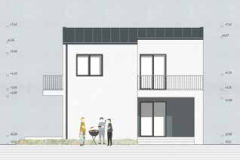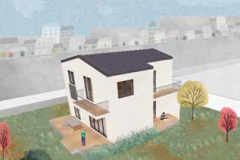Cubic Houses Reinterpreted
The Grafit Studio’s Sample Designs
Text and concept: Grafit Studio
The designs for the Lechner Centre’s 2019 competition for the idea of a model design allow for the redesign of the well-known “cube house” type design into expandable detached family houses that meet today’s needs and trends. Grafit Studio architects designed variations for both rural and urban environments, of which the urban type was selected in the concept tender and will be available in the National Model Design Catalogue from 2020 on. From an environmental point of view, a renovation or conversion project is a more environmentally friendly solution than building a new structure, partly because it uses less materials and partly because it does not take new sites away from nature. Besides, cube houses are not up to today’s standards in terms of energy efficiency. Their compact forms are their only advantages, but their energy efficiency-wise they are difficult to upgrade because of the use of inappropriate building materials and frequent poor workmanship and execution. The existing houses were built by the previous generation whose children, members of the Generation X, grew up in them, but the renovation of the buildings will be carried out by Generation Y, in line with their needs. Grafit Studio’s typological designs respond to two different environmental situations: a cube house type inserted into an urban, heterogeneous situation and a cube house type in a traditional rural setting, both adapted to their environment.
Leading architect: Piroska Varga DLA
Fellow architects: Marcell Gergely Horváth, Eszter Kocsik, Bianka Gizella Somkutas, Dorottya Répay, Gergely Lezsovits



